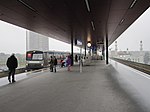De Boom Die Alles Zag

De Boom Die Alles Zag (transl. The Tree That Saw It All) is a grey poplar (Populus × canescens) tree located in Bijlmermeer, Amsterdam, the Netherlands, that survived the crash of El Al Flight 1862 on 4 October 1992. Due to the eye-shaped patterns on its trunk, the tree was considered to be an eyewitness of the accident and its aftermath. An official memorial was later built next to the tree, where the accident is commemorated every year on its anniversary. It is also a part of a larger monument, The Growing Monument (Het Groeiend Monument). The tree was damaged due to the crash and fire, and lost a part of its roots during the subsequent clean-up of the soil. This made it necessary to support it with two cables attached to neighbouring trees. The soil under it was replaced in 2017 to stimulate root growth. Its condition improved in 2021 according to pulling tests, but the tree is still supported by the cables to prevent it from falling.
Excerpt from the Wikipedia article De Boom Die Alles Zag (License: CC BY-SA 3.0, Authors, Images).De Boom Die Alles Zag
Pa Sembrug, Amsterdam Zuidoost
Geographical coordinates (GPS) Address Nearby Places Show on map
Geographical coordinates (GPS)
| Latitude | Longitude |
|---|---|
| N 52.319 ° | E 4.9741 ° |
Address
De Boom die alles zag
Pa Sembrug
1103 EZ Amsterdam, Zuidoost
North Holland, Netherlands
Open on Google Maps









